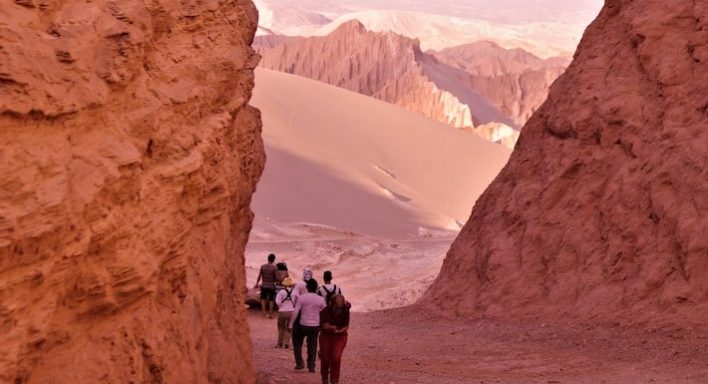By Nancy Wigston
Famously long and narrow—2,653-miles long with an average width of only 110 miles–Chile has been jokingly called the barrier that keeps Argentina from the Pacific. The Andes Mountains across Chile’s eastern frontier do a fairly good job of separating the two countries. The first Europeans arrived here in 1520 when Ferdinand Magellan made landfall after discovering the southern straits around South America that bear his name. He then continued across the Pacific in an ultimately failed effort to circumvent the globe.
Already resident in Chile were half a million “people of the land,” or Mapuche, a communal, hunter-gatherer society, at home in Chile’s fertile valleys since 500 BC. Resisting the conquistadors’ assertion of power, they fought against the invaders. In the mid-19th century, the Mapuche were defeated by superior weaponry and imported diseases like smallpox. Today indigenous peoples make up about 10% of Chile’s population of 18.73 million, the majority of whom are descended from Spanish, Mestizos, and a smattering of newcomers from other European countries as well as the Middle East.
At first a Spanish agricultural colony, Chile’s vast stores of copper and other valuable minerals (lithium, nitrates, gold) meant the narrow land was perfectly positioned to supply world demand for the mineral. Chile still produces the planet’s largest amount the mineral called “red gold,” and agriculture production continues to flourish, especially wood, fruit, and seafood. Independent from Spain since 1810, Chile is considered one of South America’s wealthiest nations. Cultural sophistication, renowned wine from the Maipo Valley a 35-minute drive due south of Santiago and a booming adventure tourism sector have catapulted the narrow nation onto the “must-see” lists of global travelers.
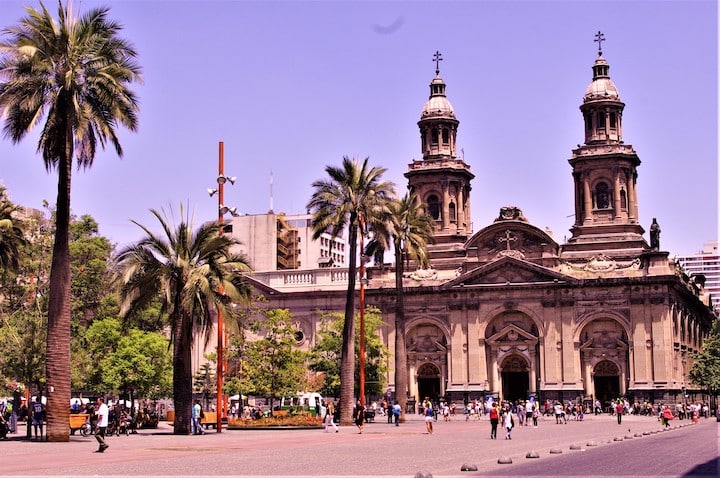
Founded in the 16th century by conquistador Pedro de Valdivia, Santiago’s Metropolitan Cathedral anchors the Plaza de Armas. Destroyed by an earthquake, it was rebuilt in the classical Italian style over the course of 300 years. Any exploration of Chile’s capital should start at the Plaza de Armas.
North of Chile, separated by a short (585 miles) border, lies Peru, home to the great Inca Empire that once stretched from Quito in the north to Santiago in the south. To Chile’s Northeast, soars Bolivia, an impoverished land of towering Andes Mountains and Lake Titicaca. Directly to the west is the nation of Argentina with cosmopolitan cities distinguished by European-influenced architecture and a love for bookish coffee houses.
In Buenos Aires, folks worship the tango, in Santiago, a poet won people’s hearts. Nobel Prize winner Pablo Neruda is Chile’s “flag,” tourists are told while visiting La Chascona, Neruda’s home in the bohemian Bellavista quarter Designed by Neruda —“a sailor on land”—the house is meant to resemble a ship. “Ahoy! Ahoy!” signals the beginning of English, French, German, Portuguese and Spanish tours along the rope-lined path into the three-floored villa, where Neruda, for whom love and laughter were inseparable, labelled his salt-and-pepper shakers “morphine and marijuana.” A secret passage leads to the second floor and a sensual painting of the poet’s third wife by his friend, Mexican artist Diego Rivera (Neruda’s face is hidden in her hair)
Revered for his love poems (“Love is so short, forgetting is so long”), Neruda, was once hunted for his political beliefs. He dramatically escaped Chile on horseback over the southern Andes to his exile (1948-51) on the island of Capri in Italy. Capri was the setting for the film portraying this period in Neruda’s life, 1996’s Il Postino.
Soon after the 1973 coup ended with the suicide of his close friend, socialist President Salvador Allende, Neruda died. His house was savaged by soldiers and so many books were burned that the ashes blocked the water in a nearby canal. A guide exclaims, “It was a cultural tragedy.” For Chileans, the period of Augusto Pinochet’s brutal reign (1973-1990) remains a nightmare. To understand what happened, visit Santiago’s Museum of Memory and Human Rights {muesodelmemoria) at Matucana 501, in Metropolitan Santiago.
On October 25, 2019 a million people took to Santiago’s streets, protesting what began as student-led anger over transit fare increases. This civil unrest was rooted in the income inequalities built into the Pinochet-era constitution. A year later, in a referendum delayed by the pandemic, almost 80% of voters said “yes” to revamping that constitution. However, civil unrest–answered by authorities’ “sips and spits” (water cannon and tear gas)—erupts from time to time.
Yet visitors find Santiago welcoming, even familiar. There’s a good subway system, plenty of parks, a mix of modern and 19th century architecture that could pass for Spanish or French. Fresh orange juice stands are everywhere, restaurants serve exquisite ceviche and thin-crust pizzas. City strolling is a pleasure. Parque Forestal is home to the 1910 Beaux Arts-style National Museum of Fine Arts. Tree-filled Parque Quinta Normal has a boating lake, picnic grounds and Natural History Museum. In the capital’s heart, Plaza de Armas, gauchos and their ladies recreate the pounding energy of traditional South American dance.
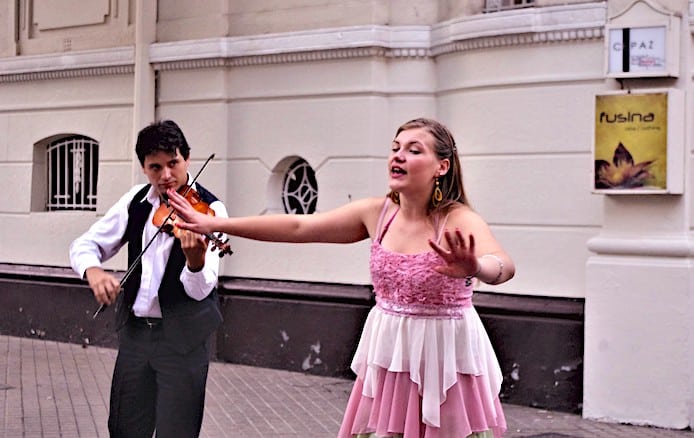
A 16-year old soprano and her violinist accompanist perform popular arias in the pedestrian streets immediately below central Santiago’s Santa Lucia Hill, where Charles Darwin, visiting the city from aboard his ship, The Beagle, gazed in admiration at the horizon in the 1830s.
Other Plaza entertainments include drummers and puppet shows. Tourists pose for photos on stuffed donkeys, stylish Chileans get their shoes freshly shined, and the entire scene is anchored by the Metropolitan Cathedral, founded in the 16th century by conquistador Pedro de Valdivia, destroyed several times by earthquakes, and completed in ornate classical Italian style three hundred years later. At the Plaza’s northern edge, that lavish white wedding cake structure is 1908’s Central Post Office, a fine example of Spanish/Chilean colonial architectural exuberance.
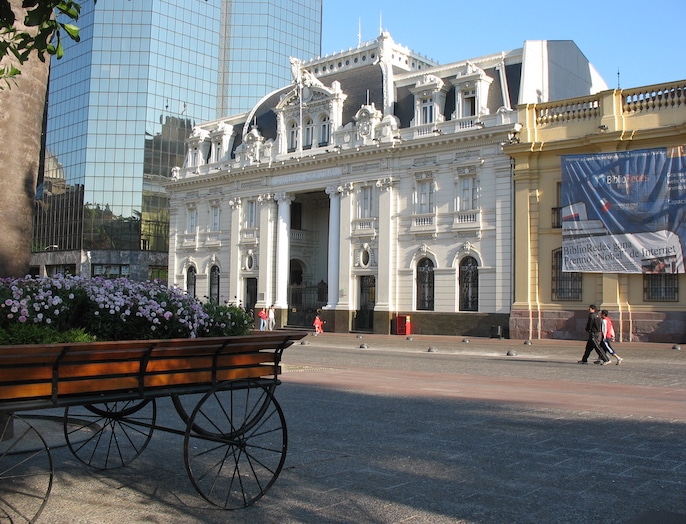
The wedding cake-style Post Office anchors the northern corner of the Plaza de Armas, across the grand Plaza from the massive Metropolitan Cathedral considered to be country’s beating heart.
Walking Santiago’s neighbourhoods reveals a sophisticated city of relaxing cafés, outdoor bistros, chic Chilean fashion designers, book vendors and street performers—from jazz saxophonists to opera singers–a friendly metropolis that combines old worlds and new.
Atacama
Should the unfamiliar, the enchanted, excite your travel dreams, head north 765 miles by air–a two hour flight–to Atacama. (That’s 953 miles by road, and buses are available.) Calama (pop.180,000) is distinguished by its reverence for copper—the bright metal decorates churches and government buildings and a copper statue of a miner, drill in hand, presents a change from heroic generals on horseback. Ten minutes away by taxi is Chuquicamata (Chuqui for short, pronounced CHOOchi), home of the world’s largest open pit copper mine. Nationalized by Allende in 1970, Chuqui is a source of immense pride for Chileans: copper and its by-products (gold, silver, molybdenum) are known as “Chile’s salary.”
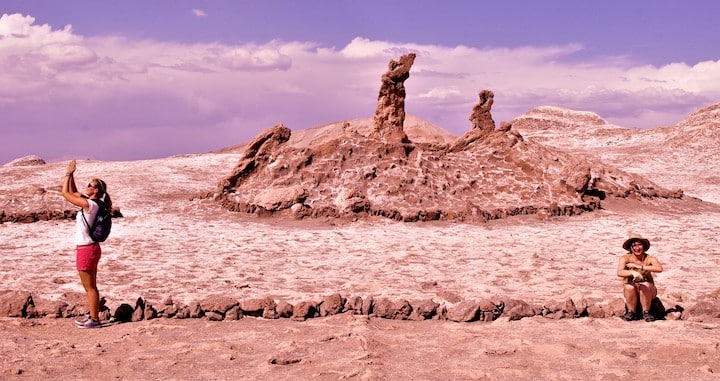
The Atacama Desert offers solitude, silence and excellent photographic opportunities.
The almost four-hour mine tour is a wonder. (Coldeco Mine Tours) An introductory talk is followed by a bus ride through a ghost town, since health concerns about copper dust forced everyone to move to Calama in 2007. The bus takes us close to a pit that looks like an upside-down skyscraper. Pit dimensions are vast: 2.7 miles long by1.9 miles wide and 3,000 feet deep. An around the clock stream of German-made trucks circle upward in a growling parade that attracts 40,000 tourists a year. Donning hard hats, we view the spectacle from metal bleachers. This is a working mine, everyone has signed waivers. No one ventures inside.
Ninety minutes northeast by road from Calama is San Pedro de Atacama, population 2,500, an oasis in the foothills of the Andes. They call Atacama “the driest desert on earth,” although it rains occasionally—and when it comes, it’s tropical. Viewed from space, Atacama is the only brown patch on an otherwise blue planet. At 8000 feet above sea level, San Pedro looks like a set from a western movie: dusty streets, small wooden or adobe buildings. The heart of Atacama’s eco-tourism boom, San Pedro attracts backpackers, families, adventure seekers, and honeymooners to its hostels and hotels.
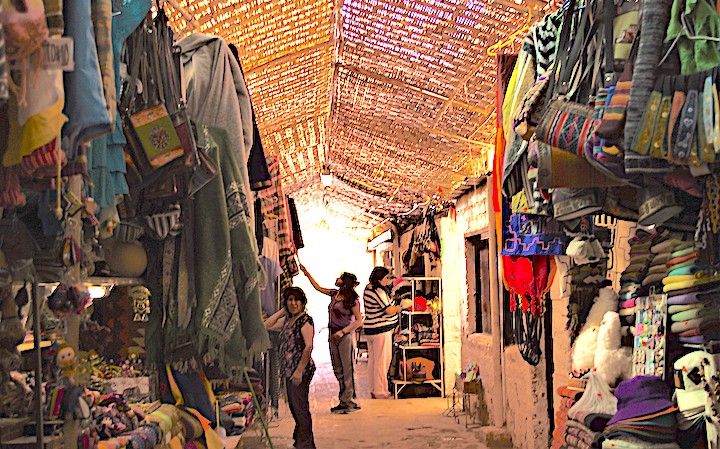
Pottery, indegenous clothing and other gadgets more useful than you might think make the craft market in San Pedro a great place to shop.
A typical desert day might start with a guided hike through Death Valley, five miles from San Pedro. Sculpted by sand-laden winds, the valley is devoid of life, save for the lizards that live on nearly invisible desert plants. The sun beats down, the wind blows. Some hikers chase sunhats snatched by the wind through scrub and rocky pathways. Every so often a heap of stones called an apchota appears. The stones mark where indigenous messengers stopped for food, water, and coca leaves, in pre-Columbian times.
A century ago, drovers from Argentina brought beef herds along this trail, food for the legions of workers that labored in Chilean saltpeter mines until the 1940s. In one famous event, corralled animals, panicked by an electrical storm, stampeded over these cliffs to their deaths. Hence, Death Valley. A chilling tale, yet when the gusting wind drops, the valley turns magical. As if on cue sandboarders appear, their arms spread out like wings, gliding down high dunes of smooth crystalized gypsum. Boarding draws many youthful tourists, which explains the many colorful sand/surf boards for rent in town.

Sandboarding is popular in Chile’s Atacama Desert
For sunset, our bus takes us to on a short drive west to Moon Valley, where crowds gather to drink in a kaleidoscope of changing colors–orange, purple, gold, rose—while the sun dips behind the Andes on the far horizon. Romantic-sounding Moon Valley in fact pays homage to the 1969 American moon landing, an event watched on television by San Pedro’s Jesuit priest, Gustavo Le Paige. Like San Pedro, Moon Valley resembles a Hollywood movie set in pre-historic or mythic times: dinosaur-shaped rocks, fantastic-beast rocks, eerie moonscapes of salt, gypsum and clay.
Humans must adjust to Atacama’s high altitude, so most visitors take it easy on day trips to the Valleys of Death and Moon, sip coca tea, visit Caracoles street to shop for silver or woolen fashions, or examine Bolivian weavings in the craft markets, before heading up to the Tatio Geysers. Groups depart at 4.30 AM in minibuses, wearing all their warm clothes against the freezing desert temperatures. Bone-rattling convoys of vans head two and a half miles above sea level, to witness the steamy geysers, believed by the ancients to contain the souls of the dead.
The evening before, preparations might include drinking medicinal teas, with coca leaves and the local Chilean herb called rica rica: natural prophylactics against altitude sickness. The surreal sight of geysers shooting 30 feet into the air from lava buried 9,000 feet below our boots is otherworldly. With slow careful steps tourists approach the bubbling geysers. Dawn breaks and the sun illuminates the profile of the volcano affectionately called “Aging Grandfather.”
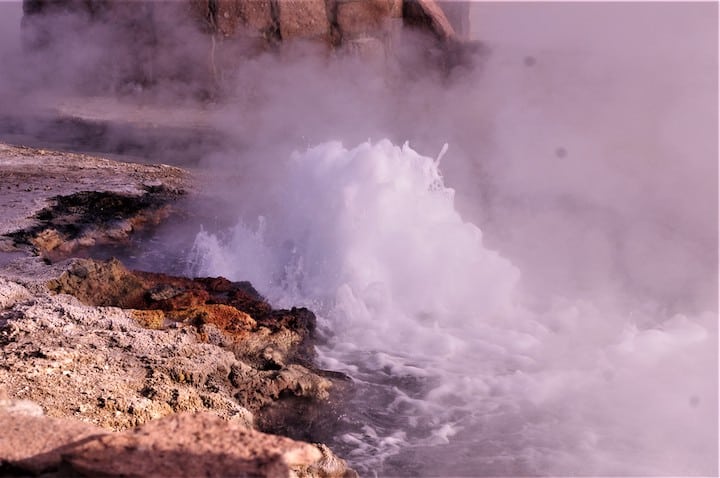
The Tatio Geysers, integral to any Atacama adventure, are the largest geyser fields in South America. They bubble, sputter, and explode upward daily from before dawn to early afternoon, surrounded by volcanoes that seem topped with white snow but in fact is pale volcanic ash.
Visitors may be forgiven for feeling like arrivals from another world. (These are the world’s third largest geothermal geyser fields, but Old Faithful has its fans for sheer spectacle.) In fact, hunter-gatherers lived in Chile’s north 11,000 years ago. Incas from Peru invaded Atacama just 90 years before the Spanish, seeking to expand their growing empire. On the road back to town from the geyser fields, warm clothes are ditched for swimming in a muddy-looking thermal pool. The morning sun reveals previously dark landscapes as bright meadows, lively with vicunas, llamas, flocks of birds wheeling in crayon-blue skies—a dramatic contrast to yesterday’s trek through lifeless canyons.
Two-hours after leaving Tatio, we arrive back in San Pedro, where we inspect its bright adobe church. Built in 1744, its cactus wood ceiling bound together by leather straps, the church stands kitty-corner to Father Le Paige’s archeological museum, now overflowing with artifacts Le Paige collected after his arrival in San Pedro in 1955, currently closed as a larger space is sought. The priest’s endearingly large-eared statue smiles beatifically toward the plaza. On clear San Pedro nights, the canopy of stars seems close enough to touch, the Southern Cross hanging low on the horizon.
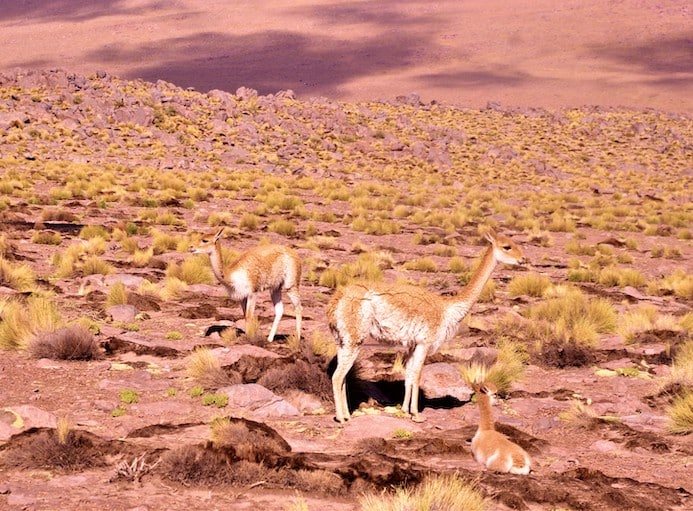
Vicunas, a species of camelids on the verge of extinction as recently as fifty years ago, now number in the hundreds of thousands. Coveted for their silky woolen coats, herds of vicunas run wild in the alpine meadows of the high Andes where these were spotted on the descent from the Tatio Geyser fields.
Atacameños have recently been reclaiming their heritage. On Columbus Day (Oct 12) black is worn, a sign of mourning for their ancestors’ treatment by invaders. Most important is the role played by sustainable tourism: tourists are urged to show respect when photographing people, and to conserve scarce resources, especially water. (Showers are kept short.) Fees levied when visiting sites belonging to native peoples go to local councils and not to the federal government. No noisy discos, bars close by midnight.
Atacama, with its weirdly wind-whipped rock formations, turquoise lagoons, white flamingos and salt flats, is an otherworldly destination. Local sheep and goats provide sustenance, and fresh fish, fruits and vegetables are trucked in from further afield. San Pedro menus feature mango soup, grilled fish and lamb, Peruvian Pisco sours and Chilean wines, while BB King sings the blues on sound systems.
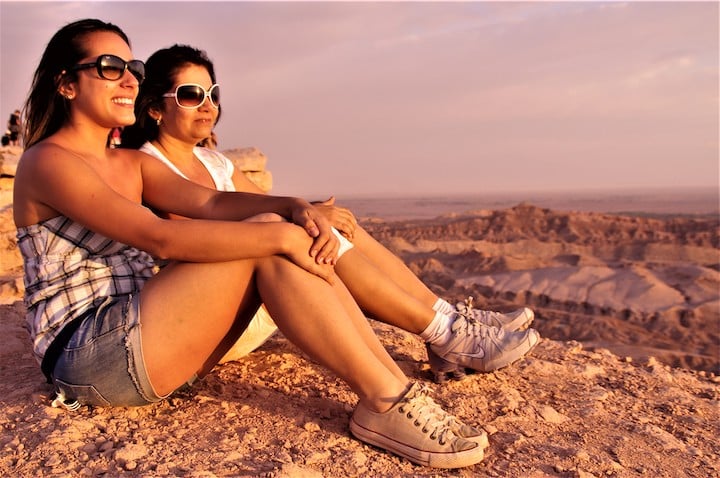
Atacama sunsets in Moon Valley outside San Pedro almost vibrate with hues of red and orange.
Seductive San Pedro de Atacama certainly is. But here’s the thing. It does rain dramatically, every eleven years or so, as happened on my second visit. First came a noise—yes, that was hail–then flooding, then a town-wide power outage (many restaurants own generators), then—surprise–it was time to get out of Dodge. I had a flight to catch, an hour away in Calama.
The skies had cleared but a great hole in the main road posed problems. Didn’t know about the hole—or the line of tractor trailers waiting on the highway for its repair–so a last blissful afternoon was spent at Laguna Cejar, floating in the mineral-rich water, and chatting with Leonard Cohen fans from Britain. Thankfully, the cavalry was waiting at my hotel, courtesy of Desert Adventure Tours, their driver and his Land Rover. Driving fast over rough back roads was a swell way to end the trip, mesmerized by undulating desert hills decorated with what looked like icing sugar, but in fact was salt, forced from the earth by the rains. Enchanting. If you want unforgettable, choose Atacama.![]()
Nancy Wigston is an award-winning travel writer whose work has appeared in England, South East Asia and her native Canada


